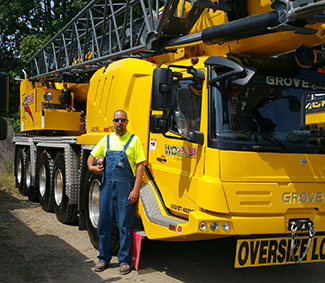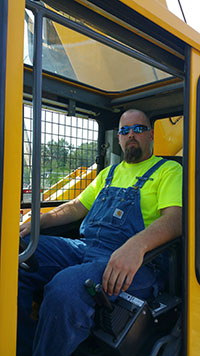CCO Operator Profile: W.O. Grubb’s Blair Carlton

September 2015—Originally a mechanic, at 6'6" tall Blair Carlton realized that he was better suited to be in the cab operating cranes than he was working in confined spaces. A friend was an apprentice through IUOE Local 147 and invited Blair to come help him and his friend’s father—a crane operator—on a job where they had to recover a flipped excavator with a crane. Blair was hooked: after that he knew he wanted to operate cranes and joined the crane operator apprenticeship program at Local 147.
He began operating cranes 16 years ago and, while still completing his IUOE apprenticeship, in 2001 he was hired by W.O. Grubb through the local union shop. Today he’s W.O. Grubb’s field operations coordinator—more commonly known as the “yard supervisor”—at the company’s headquarters location in Richmond, Virginia, where the fleet consists of mobile, all-terrain, and rough-terrain cranes.
As yard supervisor Blair does whatever needs to be done, and his current role requires him to operate a variety of cranes on a daily basis. His broad skill set and varied experience allows him to get involved with anything from crane setup to emergency situations. In the yard, one of Blair’s main responsibilities is making sure all cranes are prepared for their next job. Blair also has many other duties such as traveling to job sites to ensure cranes are placed in the correct location and set up correctly, and he gets involved in projects that are “push jobs” where there is a fast approaching deadline.
 Local 147 requires that all operators that graduate from its four-year apprenticeship program obtain CCO certification, and Blair is currently CCO-certified to operate TLL and TSS mobile cranes. W.O. Grubb also requires all of its operators to be CCO-certified, and Blair sees this certification requirement becoming nearly universal, especially on government jobs and when working for certain contractors.
Local 147 requires that all operators that graduate from its four-year apprenticeship program obtain CCO certification, and Blair is currently CCO-certified to operate TLL and TSS mobile cranes. W.O. Grubb also requires all of its operators to be CCO-certified, and Blair sees this certification requirement becoming nearly universal, especially on government jobs and when working for certain contractors.
The first time he took his CCO mobile crane operator certification exams he learned a lot of technical and safety information that he did not know prior to taking the exam, so earning his certification has made him a safer operator. And he sees NCCCO’s five-year recertification requirement as beneficial because it forces operators to keep up to date with the latest OSHA regulations and ANSI standards.
Having his CCO certifications makes him much more confident on the job; he says, “I can explain to customers about safety rules and proper setup for the crane I am running and be sure that I have the correct information.”
Although not currently CCO-certified as a rigger or signalperson, he learned the essentials for performing these functions during his apprenticeship and he’d like to earn these CCO certifications in the near future. He thinks more federal regulations requiring riggers and signalpersons to be certified would be better than the current “qualification” requirement because their competency is crucial to safe lifting when the operator is operating in the blind. Also he feels it’s essential that operators have at least basic rigging and signaling competency so that everyone is on the same page.
Blair currently works with many types of cranes, but he mostly operates hydraulic telescopic cranes from 6½ tons to 550 tons capacity. Several cranes that he’s enjoyed operating over the years are Grove’s 550-ton flagship 7550, the Grove 5120 GMK 120-ton all-terrain crane, and a Liebherr 300-ton crane. The Liebherr 300-ton crane is his favorite type of crane to operate. A memorable job involved spending three months operating a Grove GMK5120 120-ton all-terrain crane on a project in Alaska near the Bering Sea. The project was to build the backup power and communications defense systems for the United States military.
When not working, Blair enjoys hunting and spending time with his family. He recently purchased a boat that he uses to go fishing with his six-year-old son.